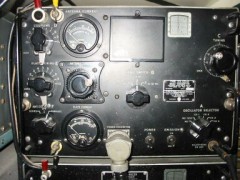
The TCS transmitter: Notice the RF output terminals on the upper left of the front panel, right next to the "antenna coupling" control. (click for a larger image)
by Kevin Strom, WB4AIO
RECENTLY I was listening to WA1HLR use his modified Navy TCS transmitter on 75 meters, and it brought back memories of my early days on the amateur bands. In 1972 I bought a World War II surplus Navy TCS transmitter, built by Collins, from military surplus dealer John Meshna, via mail order.
The transmitter looked shiny and almost new when it came out of its thick, multi-layer wooden packing crate — which I believe was also a 1940s original. It had that odd smell that electronics of that era often had — something to do with the anti-mildew “tropicalization” coating they were given, which also gave them a vaguely green sheen when seen at certain angles.
The TCS needed a power supply and control panel, which I built myself from parts scrounged from old radios and television sets and purchased at Arcade Electronics in Annandale, Virginia. The stock audio quality was not too good — strictly carbon-mike variety — so I ventured some modifications and soon had it sounding decent into my light bulb dummy load. But that was just an experiment.
Having only a Novice license at the time, my first goal was to get it on the air on CW. It wasn’t designed well for that mode, to say the least: multiple relays keyed multiple stages at once, including the free-running oscillator, clunking loudly and clicking and chirping like crazy on the air. Ultimately it would prove to be easier to get my Viking Valiant on CW than bother with totally redesigning the TCS. So my first rig was eventually consigned to carrier-current AM duties (feeding a reduced power signal into the AC power line, like many college radio stations used to do), so I could send my shortwave receiver’s (or my Wollensak reel-to-reel deck’s) audio around the house and the neighborhood to any AM-band radio while I did chores or mowed the lawn. That was fun.
But that isn’t what I remember most about the TCS transmitter. My most lasting memory of it is the front-panel nut-and-bolt RF output terminal, which was right next to the output tank coupling knob. It was almost impossible to tune the transmitter without getting RF burns on your knuckles. That feeling — and the aroma that went with it — is something I am unlikely to forget.